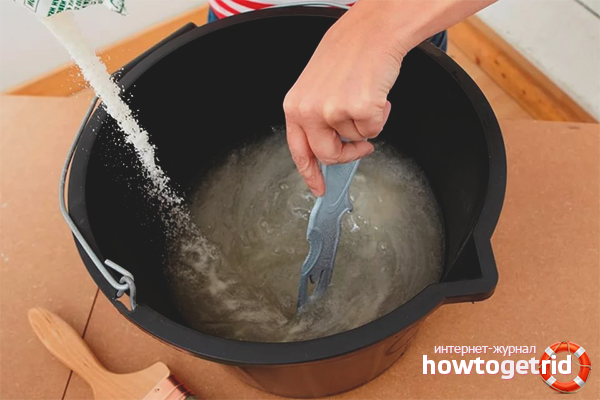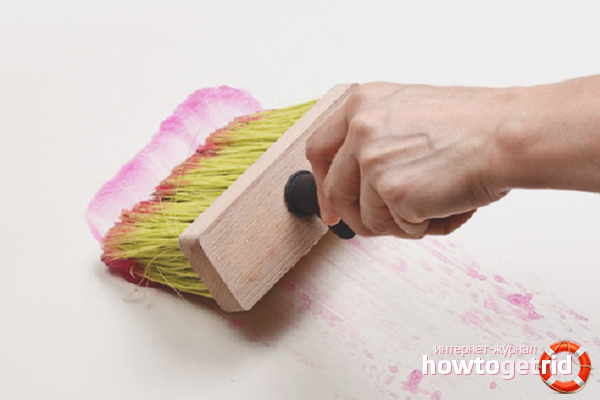The content of the article
How to dilute glue for non-woven wallpaper? In principle, this is a very simple matter. But it also has its own tricks and secrets. For example, a person who has made repairs in his home many times 100% incorrectly spread glue. Because adhering to the technology ensures that you do not have to redo the repair several times in a short time or wake up from the cod of falling off wallpaper.
And even a newbie will have to first study all the recommendations and advice so as not to mess things up. Otherwise, not one bucket of the solution will go to waste before the non-woven wallpaper is firmly glued to the wall.
General rules
Specialists finishers recommend purchasing glue and non-woven wallpaper of the same brand. Already the manufacturer accurately selects the necessary components in the best variation. If the store did not have the same brand, then buy glue from the most famous companies. Then you definitely will not have unpleasant surprises in the form of a too thin solution or, conversely, a cement mass with lumps.
If you wish, you can consult with the seller. As a rule, they always give an exhaustive answer for all types of non-woven wallpaper and glues to them. Only in the case when the seller recommends buying universal glue, you can safely judge its incompetence. For this kind of glue is able to hold only thin paper wallpaper. And then, on a carefully prepared wall.
We recommend purchasing glue for non-woven wallpaper immediately with a margin. Firstly, for pre-priming the walls. This greatly facilitates the joining of joints. Secondly, diluted glue can be safely stored for a week at room temperature, and dry - until the expiration date. Therefore, let it be. Thirdly, if breeding fails, you don’t have to go shopping to find glue of the same brand. Or there isn’t enough a liter mug to glue on the last piece of non-woven wallpaper - you also have to run to buy.
Tip. All tools and containers must be absolutely clean, without a trace of other solutions. There is nothing worse when trying to smooth the wallpaper on the wall, people ripped off thin strips of interlining with pieces of dried cement mortar or grains of sand that got into the glue mixture.
Work order
You can’t just dump the entire pack of dry mix into water and get a decent result. To spread glue for non-woven wallpaper you need to be able to. We’ll learn now.
Necessary tools and materials:
- Capacity of at least 10 liters. Bucket, basin, large bowl.
- Glue of the selected brand.
- Warm water. Not cold and not hot!
- Stick, fun, whisk, drill, construction or household mixer.
- Measuring cup or spoon
- The desire to quickly get rid of the nervous occupation - repair.
Getting down. Pour exactly the measured amount of clean warm water into the container. Prepare the required amount of dry mix in advance. Always use a measuring cup or spoon. A mistake of even 50 g per eye can be fatal.
Now quickly stir the water until a funnel forms. We begin to pour dry glue with a thin even stream. All this time, continuously stirring water in one direction. We recommend that you use a stick or funk to begin with. The mixer will not make the desired funnel, it will simply immediately whip the glue on the surface, preventing it from properly contacting with water. And the dry mixture also starts to fly out of the tank.
After pouring out the entire measured dose of glue, we interfere for another minute. Now you can take a drill with a nozzle or a construction mixer. A power tool will break up all the small lumps that might have formed much better.
It is perfectly acceptable to use a conventional kitchen mixer with whisks, but there is one trick. To prevent splashes of diluted glue from flying in all directions, leave only one nozzle. Two will give foam and scatter your finished glue on the walls and along you. And one simply mixes the solution qualitatively.
Now you can wait 14-16 minutes until the finished mixture is saturated with water and swells. During this time, glue for non-woven wallpaper will become a little denser. Check consistency. It should be like thick jelly or sour cream. If the finished glue is too thick in your opinion, then add another 200 ml of pure water. Then mix thoroughly again.
All manipulations for additional dilution are recommended to be performed in the first half hour after kneading. Then the glue will swell. Instead of a ready-made plastic mixture, you will get water with floating clots. Even if you manage to stir such a brew to a homogeneous mass, no one guarantees the preservation of all the properties declared by the manufacturer. This will already be a violation of the process. Therefore, try to have time to do everything in the first 30 minutes, no more.
Now you can safely start gluing the wallpaper. You yourself spread the glue.
Tip. Non-woven wallpaper does not smear with glue. It is applied only to the wall, and then a dry section of the desired length is glued.
Some useful tips
- Always read the manufacturer's instructions on the packaging before starting work. Because it is customary for Russian people to grab instruction when they understand that something has gone wrong.
- The exact proportions of the amount of water and glue are not intentionally given here. Because at each firm they differ significantly. The only recommendation: always take water 0.5 l less than what is written in the instructions. It is better to add this amount later, if the mixture seems to be thick. Because the liquid glue can no longer be thickened.
- Do not plump all dry mix into water in one fell swoop. It will turn out a dense lump, which will then be difficult to mix. And lumps of finished glue can leave ugly swellings or small bubbles under the non-woven wallpaper.
- By the way, non-woven wallpaper sticks better to thick glue. When used correctly, it is difficult to find the joints of the sheets themselves.
- If your joints peel off after drying, we recommend that you purchase a special pencil for gluing. It gives a thin but strong adhesive layer. And the thickness of the rod suggests convenient use at the joints. In addition, he leaves no stains and other marks in the dark drawing.
- Some sources recommend adding PVA glue to the mix. Say, this way the wallpaper holds better. We do not recommend doing this. If all the instructions are followed, the wallpaper will also be of high quality without PVA. And during the next repair, it is likely to remove the old wallpaper along with pieces of walls. After all, PVA has very good adhesion.
- Do not cook glue for non-woven wallpaper in the old fashioned way, from starch or flour. This is the last century. Such a mess completely holds the usual paper wallpaper on the wall. But the non-woven ones will fall off whole layers remarkably within a week. At the same time, you will not be able to stick them onto normal industrial glue again. Because the paste disrupts the structure of the interlining. Do not create problems and headaches for yourself. If your budget includes the amount of good wallpaper, then allocate funds for the right glue. It is not so expensive.
How to dilute glue for non-woven wallpaper? Now you know all the technology for sure. And easily and effortlessly in any situation, bring the right amount of glue to the desired consistency. Have a good repair!
Video: how to breed wallpaper glue











Submit